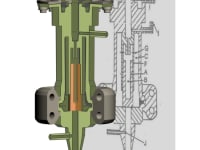The number of deaths and serious injuries to military personnel from IEDs accentuates the need to develop remote methods of clearance. This invention uses remote clearance over a 100 metre range using surface seismic Rayleigh waves, which can be produced repetitively by a seismic pulse generator capable of being mounted on a light vehicle.
Rayleigh waves are large amplitude, low frequency waves which travel just below the ground surface and have compressional and dilatational components. These are the waves which cause ground breakup and building damage in earthquakes. Maximum ground stresses occur within a surface layer less than one wavelength thick, which is where IEDs are currently set. The frequencies of the Rayleigh wave modes lie in the range 2-15 Hz, the ideal range for triggering most IEDs, which have relatively long time constants for initiation.
The basics of a shock wave-driven seismic source suitable for generating large amplitude Rayleigh waves repetitively have been described by Melvin and Clarke (Proc. Roy. Soc. A450, (1995) 351-370) and originally by Melvin (US Patent 4667766; 1987). It operates by the instantaneous opening of a shock wave valve separating a chamber containing helium at 100 bar pressure from a 2 metre 5 cm diameter tube containing air at atmospheric pressure. The gas dynamics of the process are such that a shock wave develops in the tube. By firing the shock into a surface borehole, transient reflected shock pressures of ca.100 bar are developed and compressional, shear and Rayleigh waves are propagated into the subsurface. The shock wave valve then closes automatically and the helium chamber pressurises to enable repetitive firing. The design of such a device for Rayleigh wave generation is shown in Fig. 1.
The specific behaviour of the Rayleigh wave will depend on the geology of the area in which the IED's are laid. Fig.2 shows Rayleigh wave results for a typical clay area where compressional and shear wave velocities are 2600 and 1400 metres per second respectively. Spectral analysis shows that Rayleigh wave frequencies are 10 Hz or less and the potential vertical ground displacxements in the sublayer at 100 metres range correspond to ground stress forces of 18 kilograms, which would be enough to initiate many IEDs. For an area of differing geolgy, where a sublayer of unconsolidated sand forms a top layer over strata of clay-like rocks, the compressional and shear wave velocities in the sand layer are 600 and 400 metres per second respectively. Spectral analysis shows that 77% of the Rayleigh wave energy still lies in the 10 Hz region, but the rest is lost to 20 Hz and 40 Hz components. Even in this unfavourable case, with potential ground displacements of 0.5 metres, there is enough ground stress generated to trigger IEDs.
Like this entry?
-
About the Entrant
- Name:Alec Melvin
- Type of entry:individual
- Software used for this entry:Fortran
- Patent status:none





